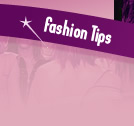![]()
![]()
![]()
![]()
![]()
![]()
![]()
![]()
![]()

![]()
![]()
A definition of fashionWhat it is, who decides what's 'in'Fashion is always changing, slightly elusive, extremely seductive. It has the power to transform an image and make a social statement. What is fashion anyway?Dictionary.com's definitions:
To some, fashion is an art form. To others, it is almost a religion. But for most people it is a method of utilizing clothing, accessories and hair to show or hide something about yourself. You can use fashion to express yourself, to serve as an extension of your personality: goth, skater, soccer mom, professional. Or you can use fashion to disguise your true self: a conservative in vamp clothing, a vamp in conservative clothing. Fashion statements can be made with clothes, accessories, shoes, hair, makeup, even your cellphone.
Who decides what's in?Designers can greatly influence what direction fashion will go in. Tom Ford of Gucci and YSL, Miuccia Prada of Prada and Miu Miu, Marc Jacobs of Marc by Marc Jacobs, Marc Jacobs and Louis Vuitton are all considered directional designers (Ford for sexy looks, Prada for remixing classics, Jacobs for vintage-inspired styles). Working five or six months ahead of the season, the press attends fashion shows presenting designer collections; the media will then give editorial coverage to trends they think their readership is interested in. Store buyers work many months in advance of the season to place orders with manufacturers for styles they think their customers will want to buy. Celebrities and other opinion leaders (socialites and other glitterati) are usually the first to sport new looks, spurring the buying public into accepting emerging trends. So everyone from big-name designers to celebrities may be behind influencing the direction fashion will go in. But ultimately, it is you, the consumer, who will decide what is "in" when you choose whether or not to buy into a trend.
Where are the world's fashion centers?New York, Paris and Milan are considered the major hubs for designers and manufacturers of fashion apparel and accessories. London, Los Angeles, Toronto, Hong Kong, Sydney and Sao Paolo, in addition to hundreds of other smaller market areas are host to excellent designers and manufacturers.
How can I work in fashion?Depending on what you want to do -- from designing to retailing -- there are many paths you can take to get to your destination. Education is a vital ingredient: many universities offer excellent fashion merchandising courses. Work experience is another necessary step to working as a professional in the fashion industry. Experience at the retail level (as a sales person in a store) is a great way to get a feel for how consumers buy, mix or reject clothing. Many students are initially attracted to fashion because it seems like a glamorous business: to some degree it is. But the majority of clothing and accessories that are designed, manufactured and sold have absolutely nothing to do with the glitzy shows associated with famous designers. The majority of people working in fashion have behind-the-scenes jobs at less-than-glamorous wages. Regardless, most who work in the industry are charged by its vibrancy and creativity and get rewards other than fame and fortune (a fun job, creative outlet, etc.). |
![]()
![]()
ęCopyright 2025 i-textile.com All rights reserved.
Unauthorized
duplication in part or whole strictly prohibited by international copyright
law.
![]()






